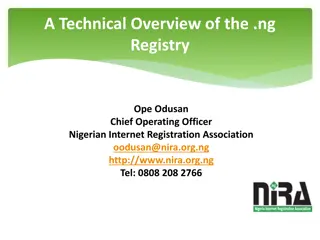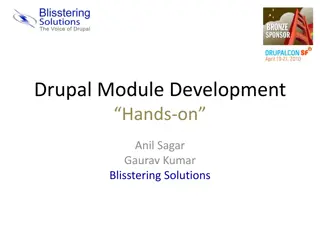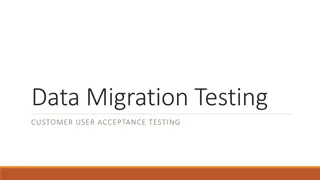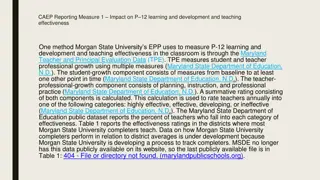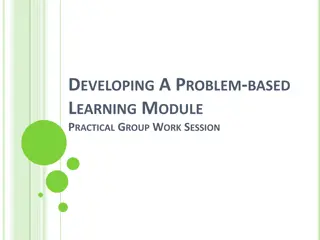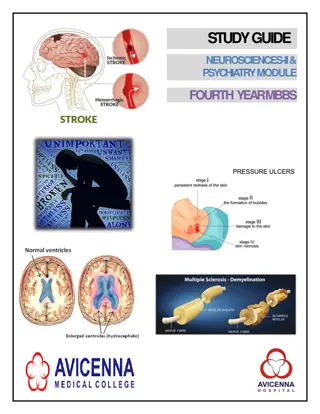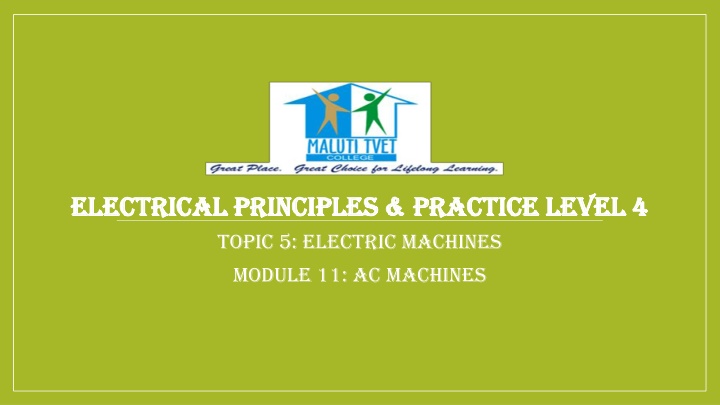
Electric Machines: AC Motors Operating Principles
Gain insights into the operating principles of AC electric machines, focusing on three-phase and single-phase induction motors. Learn about key components, characteristics, losses, and factors affecting performance. Enhance your knowledge of electric machines with detailed explanations and visual aids.
Download Presentation

Please find below an Image/Link to download the presentation.
The content on the website is provided AS IS for your information and personal use only. It may not be sold, licensed, or shared on other websites without obtaining consent from the author. If you encounter any issues during the download, it is possible that the publisher has removed the file from their server.
You are allowed to download the files provided on this website for personal or commercial use, subject to the condition that they are used lawfully. All files are the property of their respective owners.
The content on the website is provided AS IS for your information and personal use only. It may not be sold, licensed, or shared on other websites without obtaining consent from the author.
E N D
Presentation Transcript
ELECTRICAL PRINCIPLES & PRACTICE LEVEL 4 ELECTRICAL PRINCIPLES & PRACTICE LEVEL 4 TOPIC 5: Electric Machines Module 11: AC Machines
Learning outcomes By the end of this module, students will be able to: Unit 11.1: three-phase induction motors Explain the operation of a three-phase induction motor Describe and explain the operating characteristics of a three-phase squirrel-cage and wound-rotor motor Calculate the synchronous speed and slip of an induction motor List losses that occur in an induction motor List the factors affecting the performance of induction motors Unit 11.2: Single-phase induction motors draw and explain, with the aid of circuit diagrams, the operation of single-phase AC motors. Sketch the typical torque-speed characteristics of the AC motors in the range.
Operating principles of three-phase AC induction motors When a three-phase stator windings of induction motor are fed by a three-phase supply, a magnetic flux of constant magnitude, but rotating at synchronous speed is set up. The flux passes through the air-gap, sweeps past the rotor surface and so cuts the rotor conductors which as yet, are stationary. Due to the relative speed between the rotating flux and stationary rotor conductors, emf is induced in the latter and thus current starts flowing through the rotor conductors and produces a torque which tends to move the rotor in the same direction as the rotating fields. Parts of three-phase induction motor are: The stator The rotor The end shield supporting the bearings.
The stator - The main function of a stator is to produce the magnetic flux - It is the stationary electrical part of the motor. - The stator core is made up of several hundred thin laminations. The rotor - Is the rotating part of the electromagnetic circuit. - The rotor consists of a stack of steel laminations with evenly spaced conductor bars around the circumference. - The rotor core is formed by the stacked laminations. The two types of rotor motors - A squirrel-cage rotor motor -A wound-rotor motor
Losses that occur in an induction motor - Core losses - Mechanical losses Factors affecting the performance of induction motors - Supply voltage - Loading - Line frequency - Phasing Tests on induction motors - no-load or open-circuit test - Blocked rotor or short-circuit test
Unit 11.2: Single-phase induction motors Operating principles of single-phase induction motor The moving magnetic field is produced in a single-phase motor by simulating the effect of two- phase induction motor. Types of single-phase induction motors (page 221 228) - capacitor-start capacitor-run motors - Permanent-capacitor motors - Capacitor-start induction-run motors - Resistance-start induction-run motors - Induction-start induction-run motors - Universal motors - Shaded-pole motors








